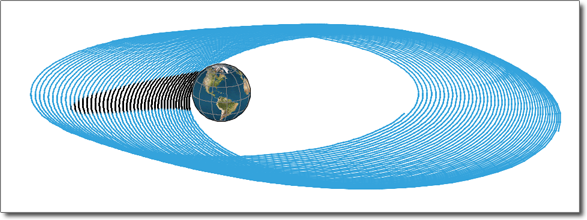|
|
LOTOS Output
LOTOS provides output in several ways: functions, values, plots, files and reports. The set of output functions can be customized by the user, further the output step-size can be specified, both useful to reduce the amount of output data. Furthermore all output functions can be plotted versus each other. Supported plot types are 2D, 3D, map plots and 3D map plots. It is also possible to create plots with value-based curve colours, for example to highlight transfers with thrust and coast arcs; or to visualize the multi-revolution orbit transfer with eclipses, as shown in the figure below. The output functions of LOTOS comprise:
- Time, Julian date and revolutions
- Position in relative and inertial frame
- Velocity
- Spacecraft accelerations
- Orbital data such as Keplerian and equinoctial elements
- Spacecraft attitude (thrust vector components, Euler angles, quaternion)
- Power system properties (e.g. solar power, battery power)
- Propulsion system (e.g. thrust, specific impulse, mass flow, throttle, burn time
- AOCS (e.g. Euler angular rates, spacecraft body rates and accelerations)
- Environment data (e.g. dwell time in Van-Allen belt, number of GEO belt crossing, solar aspect angles)
- Celestial bodies (e.g. position and angular distance)
- Ground stations (e.g. elevation)

Two dedicated files are created with additional content. The first contains the attitude of the spacecraft as quaternion as well as the state of the propulsion system (on/off) as function of transfer time. The second file contains the eclipses and provides data like Julian date, transfer time and type of eclipse.
Analyses
Several built-in analyses are customizable with user defined thresholds and are run automatically with each simulation action:
- Attitude limitations (e.g. thruster pointing in Sun direction)
- Eclipses (number of eclipses up to 30 minutes, 30-60 minutes, average eclipse duration, longest eclipse duration, etc.)
- GEO belt crossings (number of crossings, time and longitude of each crossing, etc.)
- Slew rate limitations (number and time of violations, etc.)
- Star tracker blinding (number of total blinding, occurrence of blindings, etc.)
- Thruster firings (minimum and maximum firing durations, minimum period between 2 firings for two different modes, etc.)
- Torque limitations (number of violations and when they occur, etc.)
- Visibility analysis for ground stations (total and average time of ground station contact and loss, etc.)
- Wheel momentum limitations (number of violations and when they occur, wheel momentum dumping, etc.)
Reports
- Customizable
- Automatic creation
- Pre-defined templates for hybrid transfers and electric orbit-raisings
- Access to scenario input
- Access to all output data
- Access to results of analyses
- Dynamic tables depending on output data
- Contains plot diagrams
- Contains external figures
- Header and footer with customizable CI
|

